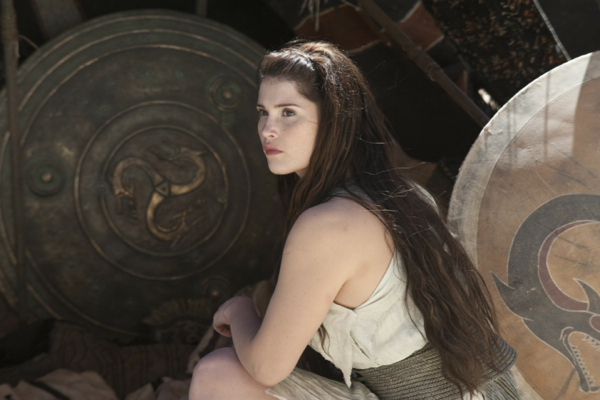Movie review by Greg Carlson
As Perseus (Sam Worthington) arms himself to do battle with the Greek gods whose blood he shares, he picks up Bubo, the R2-D2-channeling clockwork owl that delighted children in the 1981 “Clash of the Titans.” A seasoned warrior tells Perseus to leave it, and only viewers of a certain age and disposition will even notice the fleeting reference to Ray Harryhausen’s original analog achievement. Even though Louis Leterrier’s remake fails to make room for Athena’s winged wind-up, the new “Clash of the Titans” incorporates a significant number of themes, ideas, plot points, and set pieces from director Desmond Davis’ original. Neither version quite does justice to the myths and legends upon which Beverly Cross’ hybridized screenplay was based, but younger and less discerning patrons will certainly purchase tickets to the party.
In the update, Liam Neeson is Perseus’ father Zeus, gravely passing judgment on humans with the same authority wielded by an ailing Laurence Olivier the first time around. Clad in lens-flare ready armor so shiny it nearly blinds, Zeus squares off against his wheezy, underworld sibling Hades, played by a stooping Ralph Fiennes in a dusky get-up and hairpiece that makes him look like a two-pack-a-day Spinal Tap roadie. Sadly, Danny Huston’s Poseidon sees his screen time reduced to a cameo, but Neeson, who barks the order to “Release the Kraken,” and Fiennes, who whispers “You have insulted powers beyond your comprehension” refuse to be upstaged by their unruly beards.
It is generous to give “Clash of the Titans” much, if any, credit for theological analogues to contemporary society, but the film’s conflict shows sinners in the hands of angry gods. Cities are divided between the fearful faithful and the arrogant apostates, while the pantheon of deities gazes down from a version of Mount Olympus tricked out with a floor that resembles Google Earth images. Conceptually, the limits of the Olympians’ power and their willingness to directly interact with humans spice up the action, but Leterrier labors unsuccessfully to balance the unwieldy number of characters, erring on the side of videogame battles involving Perseus and his cohorts.
The 2010 “Clash of the Titans” is more phallocentric than its predecessor, even though Gemma Arterton’s Io, a sort of fairy godmother/guardian angel to Perseus, fights alongside the boys. Io is also saddled with some of the movie’s most outrageously awful dialogue (to an agitated Perseus: “Calm your storm”) and Arterton deserves some kind of honor for believably wading through the muck. The film’s other significant female is damsel in distress Andromeda (Alexa Davalos), who at least communicates a smidgen of nobility in her willingness to be sacrificed to the Kraken before she is tied up and offered for dinner.
Medusa should have been a memorable female character, but Leterrier opts to render the gorgon as a computer-generated version of the serpentine Harryhausen design, building around the face of model Natalia Vodianova. Action trumps character, however, and Perseus’ showdown with Medusa and the Kraken climax are chaotic messes of vertiginous camera movement and choppy editing that provide almost no visual context or sense of space. Feverishly crammed in with so many reminders of the inaugural edition (scorpions, Calibos, Stygian Witches, Pegasus, etc.) these first-person thrill rides cannot disguise the movie’s wearisome similarity to so many other expensive fantasy entertainments.
